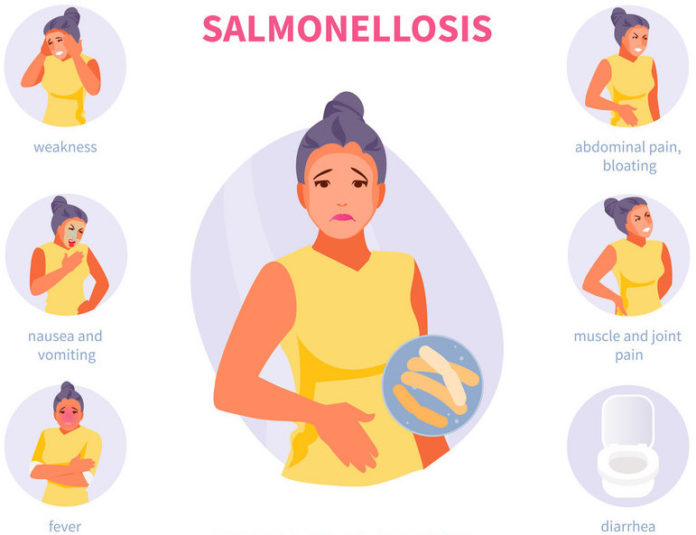Salmonella is a group of bacteria that commonly cause foodborne illness. An infection by the bacteria is called salmonellosis (or salmonella for short), and you can get it by consuming contaminated food products including raw poultry, eggs, beef, and in some cases fruits and vegetables. You can also get salmonella by handling pets — particularly some birds and reptiles.
Most people who get a salmonella infection recover fully without treatment, but in some cases, the illness can be severe enough to require hospitalization.
Causes and Risk Factors of Salmonella
Salmonella lives in the intestinal tract of humans and other animals and can pass out of the body through feces. The bacteria can infect someone when they touch or eat something that’s been contaminated with that feces. Some common ways in which a person can become infected with salmonella include:
1. Eating food or drinking water that has been contaminated with animal feces, such as:
- Undercooked beef, poultry, or fish (cooking destroys salmonella)
- Raw eggs or products containing uncooked eggs, such as cookie dough
- Raw or unpasteurized dairy or dairy products such as milk
- Raw vegetables or fruit
2. Eating food that has been handled by a food worker who hasn’t properly washed their hands
3. Petting or handling the waste of an animal, particularly one that’s known to carry salmonella, such as lizards, turtles, or baby birds
- Children under age 5
- Infants who are not breastfed
- Adults 65 and older
- Individuals with a weakened immune system (such as people with HIV or sickle cell disease, cancer patients, and those taking corticosteroids)
- People taking antacids (stomach acid can kill many types of salmonella bacteria; antacids lower your stomach’s acidity, which allows more bacteria to thrive)
- People taking antibiotics (these can lower the amount of “good” bacteria and leave you vulnerable to the infection)
- People with inflammatory bowel disease, such as Crohn’s disease or ulcerative colitis, which damages your intestinal lining and makes it easier for salmonella to flourish
- Pet owners (especially those who own birds and reptiles)
Duration of Salmonella
In most cases, salmonella is a brief illness that causes stomach cramps and diarrhea for a few days. Symptoms typically last for about four to seven days but may linger as long as several weeks.
In some cases, however, symptoms can be more severe and last longer, and may lead to hospitalization and long-term complications.
Complications of Salmonella
Salmonella infections can cause complications if the bacteria spreads from the digestive system to other places in the body, including the bloodstream, bones, joints, and central nervous system (brain and spinal cord).
Dehydration People who have a salmonella infection are at risk for losing too much fluid due to vomiting and diarrhea. Symptoms of dehydration include:
- Decreased urine production
- Dry mouth
- Sunken eyes
Bacteremia Salmonella can leave your intestines and enter your bloodstream. If that happens, infection can spread to other areas of your body, including:
- The tissues surrounding the brain and spinal cord (causing meningitis)
- The lining of your heart or its valves (causing endocarditis)
- Bones or bone marrow (causing osteomyelitis)
- Pain and stiffness in the joints
- Swelling in the toes and fingers
- Conjunctivitis
- Painful urination
Black and Hispanic Americans and Salmonella
RELATED: #BlackHealthFacts MATTER
Resources We Love
Centers for Disease Control and Prevention
From questions and answers about symptoms to the latest reports and alerts about new infections, this site is the premier source for the information you need about salmonella from the world’s leading infectious-disease experts.
FoodSafety.gov
What are the four steps you need to take for food safety? What are the bacteria and viruses you need to watch out for to keep yourself and your family safe? And how do you know what your risk level is? You can find key information about food safety — as well as information about alerts and food recalls — here on this seminal site for food safety.
National Institute of Diabetes and Digestive and Kidney Diseases
If you get food poisoning, these are the tips and recommendations you’ll need to understand what remedies may help your symptoms and how doctors treat salmonella and other infections.
Editorial Sources and Fact-Checking
- Salmonella. Centers for Disease Control and Prevention. November 24, 2020.
- Salmonella: Questions and Answers. Centers for Disease Control and Prevention. December 5, 2019.
- Salmonella Symptoms. Centers for Disease Control and Prevention. December 12, 2019.
- Salmonella Infection. Mayo Clinic. October 11, 2019.
- Drug-Resistant Nontyphoidal Salmonella. Centers for Disease Control and Prevention. 2019.
- Treatment for Food Poisoning. National Institute of Diabetes and Digestive and Kidney Diseases. June 2019.
- Four Steps to Food Safety: Clean, Separate, Cook, Chill. Centers for Disease Control and Prevention. August 14, 2020.
- Reactive Arthritis. Mayo Clinic. October 2, 2019.
- Quinlan J. Foodborne Illness Incidence Rates and Food Safety Risks for Populations of Low Socioeconomic Status and Minority Race/Ethnicity: A Review of the Literature. International Journal of Environmental Research and Public Health. August 2013.
- Typhoid Fever. Mayo Clinic. November 3, 2020.
- Guandalini S. Probiotics for Prevention and Treatment of Diarrhea. Journal of Clinical Gastroenterology. November 2011.
- Salmonella Enterocolitis. MedlinePlus. December 3, 2020.
- Salmonella Questions and Answers. U.S. Department of Agriculture Food Safety and Inspection Service. August 7, 2013.
- Salmonella Prevention. Centers for Disease Control and Prevention. February 8, 2019.
- Salmonella. Cleveland Clinic. January 17, 2019.












































